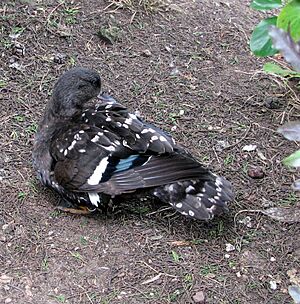African black duck facts for kids
Quick facts for kids African black duck |
|
|---|---|
 |
|
| Conservation status | |
| Scientific classification | |
| Subspecies | |
|
The African black duck (Anas sparsa) is a type of duck. It belongs to the same group as the mallard. Scientists are still studying its unique behaviors and feathers.
Contents
What Does the African Black Duck Look Like?
The African black duck is mostly black. It has clear white marks on its back. Its bill is dark, and its legs and feet are orange.
When it flies, you can often see a purplish-blue patch on its wings. This patch is called a speculum. This duck is a medium size, growing to about 48 to 57 centimeters (19 to 22 inches) long. Male ducks are usually bigger than females.
This duck lives in central and southern Africa. It is also known by other names. Some call it the black river duck. The A. s. leucostigma subspecies is sometimes called the West African black duck or Ethiopian black duck.
Where Do African Black Ducks Live?
African black ducks are mostly found in eastern and southern Africa. Their home range stretches from South Africa up to South Sudan and Ethiopia.
You can also find smaller groups of these ducks in western equatorial Africa. These areas include southeast Nigeria, Cameroon, and Gabon.
How Do African Black Ducks Behave?
The African black duck is a very shy bird. It also protects its territory. You will usually see these ducks in pairs or small groups.
They can breed throughout the year, depending on the area. The mother duck sits on her eggs for about 30 days. After the ducklings hatch, it takes about 86 days for them to be able to fly. Only the mother takes care of the young ducks. A mother duck usually lays between 4 and 8 eggs.
What Is Their Habitat Like?
During the day, these ducks like to stay in rivers and streams. But at night, they prefer large open waters. This duck enjoys living near water in the wooded hills of Africa.
It hides its nest close to running water. The African black duck builds a cup-shaped nest. It uses driftwood and matted grass to make its nest. Even though the nest is built near water, it is always above the flood level and on the ground.
What Do African Black Ducks Eat?
The African black duck is an omnivore. This means it eats both plants and animals. They often feed on larvae and pupae found under rocks.
Their diet also includes other aquatic animals. They eat plant material, seeds, small fish, snails, and even crabs.



